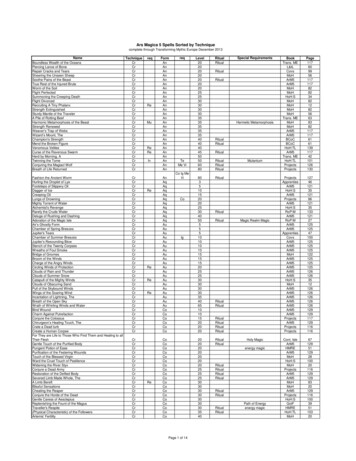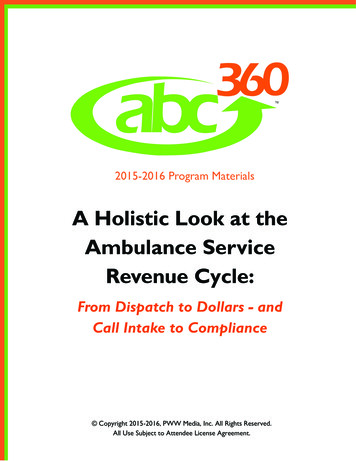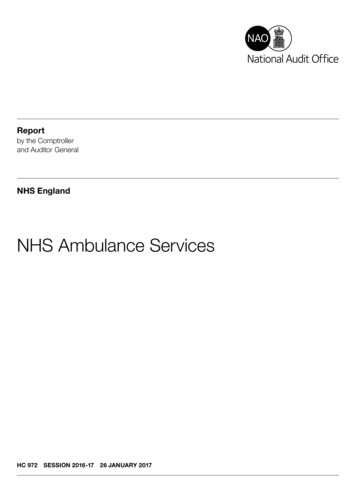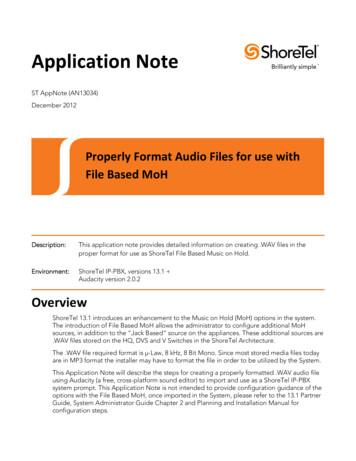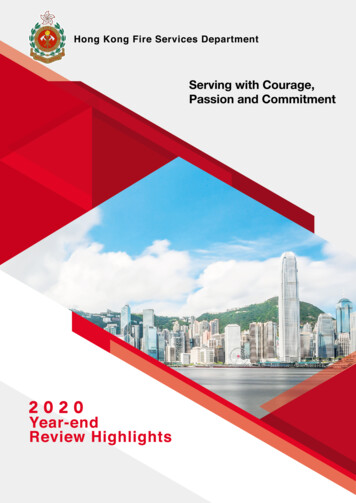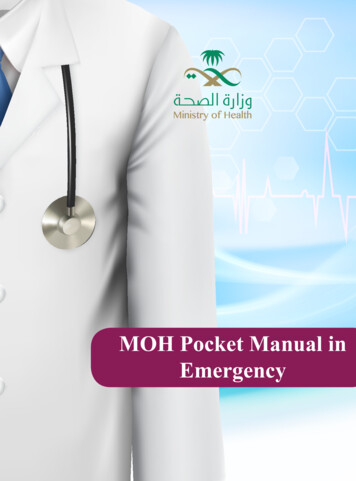![MOH STANDARDS FOR EMERGENCY AMBULANCE SERVICE (2017) [Updated 21 Nov 2018]](/img/51/emergencyambulancestandards.jpg)
Transcription
RESTRICTEDMOH STANDARDS FOR EMERGENCY AMBULANCE SERVICE (2017)[Updated 21 Nov 2018]These Standards are for the reference of providers operating or intending tooperate an Emergency Ambulance Service.These Standards spell out the minimum requirements which a provider mustcomply with when operating an Emergency Ambulance Service.These Standards and the ‘MOH Standards for Medical Transport Service(2017)’ will supersede the ‘Guidelines for Private Ambulance Service’ issuedby the Ministry of Health (MOH) on 23 April 1998.Contents:Definitions .Emergency Ambulance Service Provider . . Emergency Ambulance .Emergency Ambulance Service Crew .4.1 Composition .4.2 Emergency Ambulance Driver .4.3 Emergency Medical Technician .4.4 Ambulance Paramedic .4.5 Ambulance Nurse .4.6 Ambulance Doctor .5. Emergency Ambulance Equipment and Medical Equipment .1.2.3.4.APPENDIX 1: Definition of Medical Emergency . .APPENDIX 2: Roles and Responsibilities of Clinical Director forEmergency Ambulances .APPENDIX 3: List of Approved EMT and Paramedic Courses . APPENDIX 4: Medical Equipment for Emergency Ambulances. 224444567771-12-13-14-11RESTRICTED
RESTRICTEDEMERGENCY AMBULANCE STANDARDS1.2.Definitions1.1“Emergency Ambulance” means a ground conveyance that isused or intended to be used for transport, by land, of anyEmergency patient.1.2“Emergency Ambulance Service” or “EAS” means a service totransport, by land and using Emergency Ambulances, anyindividual suffering, or believed to be suffering, from an injury orcondition of acute or sudden onset and of an emergency nature.1.3“Emergency Ambulance Service Provider” or “EmergencyAmbulance-SP” means any entity that is approved by MOH toprovide an Emergency Ambulance Service.1.4“Emergency patient” means an individual suffering, or believed tobe suffering, from a medical emergency as defined in Appendix1. Such patients include, but are not limited to, those beingconveyed to emergency departments of hospitals, or facilitieswith appropriate medical, nursing and resuscitation support, forimmediate attention of critically ill patients.1.5All references to “Ambulance Services” in legislation will refer to“Emergency Ambulance Services” in these Standards.1.6“Emergency Ambulance Service Crew” refers to persons meetingthe requirements set out in paragraph 4.1 below.1.7“Clinical Director” means a medical practitioner holding thequalifications and performing the roles and responsibilities as setout in Appendix 2 of these Standards.1.8“Emergency Ambulance Driver” means a person meeting therequirements set out in paragraph 4.2 below.1.9“Emergency Medical Technician (EMT)” means a person meetingthe requirements set out in paragraphs 4.3 to 4.5 below.1.10“Paramedic” means a person meeting the requirements set out inparagraphs 4.6 to 4.8 below.1.11“Ambulance Nurse” means a person meeting the requirementsset out in paragraphs 4.9 to 4.11 below.1.12“Ambulance Doctor” means a person meeting the requirementsset out in paragraphs 4.12 to 4.13 below.Emergency Ambulance Service Provider (Emergency AmbulanceSP)2RESTRICTED
RESTRICTED2.1All entities that provide or intend to provide EmergencyAmbulance Service must be approved as an EmergencyAmbulance-SP by MOH.2.2The Emergency Ambulance-SP shall comply with the following:Personnela. engage a qualified Clinical Director with roles andresponsibilities as stipulated in Appendix 2, to supervise andadvise on the patient care provided;b. ensure the required training, competency and certification ofall Emergency Ambulance Service Crew as stated in theseStandards, including registration of personnel on professionalnominal rolls as required by the Ministry of Health;c. develop written ambulance care protocols for patientstransported and a training programme to ensure theproficiency of all staff in carrying out these protocols, inaccordance with such regulatory standards and guidelines asissued by the Ministry of Health;Communicationsd. set up a system compatible for communication with theSingapore Civil Defence Force (SCDF) or other designatedmedical dispatch system for ambulances;Documentatione. maintain a medical record system and an ambulance logsystem for purposes of quality assurance and audits;Equipment and Medicationf. ensure that the Emergency Ambulance is duly equipped andcarry the required supplies as detailed in paragraph 5 below;Quality Assuranceg.develop a system for performance monitoring, reporting andevaluation of the Emergency Ambulance Service provided;h.develop a framework to record, review and improve on alladverse events, such as events relating but not restricted tolapses in patient care and safety, or the safety and health ofcrew;i.develop road and vehicular safety standards to ensure that3RESTRICTED
RESTRICTEDpatients and the Emergency Ambulance Service Crew areprotected from unnecessary risks as provided under anywritten law or as directed by the Land Transport Authority(LTA).Infection Controlj.3.ensure that there are measures and protocols in place toensure adequate infection control, including: handling patients with infectious diseases, includinginstructions on appropriate action to take in the event ofan exposure to blood or body fluids/substancesincluding needle-stick injuries and other incidents; training and use of Personal Protective Equipment (PPE)such as N95 mask, gloves, gown/apron, face shield/goggles, disinfectants; decontamination of Emergency Ambulances aftertransport of patients with infectious diseases, or in eventof contamination by body fluids, and protocols forstorage, transportation and disposal of waste inaccordance with any written law or such standards/guidelines issued by the Director of Medical Services(DMS) from time to time; and immunisations for Emergency Ambulance Service Crewin accordance to requirements for healthcare workersunder the Workplace Health and Safety Act and itsregulations.2.4The Emergency Ambulance-SP shall be subject to a system ofoversight as determined by MOH. This could include, but notlimited to inspections or audits of the Emergency Ambulance-SPby MOH and/or its appointed agents for compliance with theseStandards.2.5An Emergency Ambulance can ferry an Emergency patient onlyif all Standards prescribed herein are complied with.2.6All Emergency Ambulances may attend to and ferry nonemergency patients. The Emergency Ambulances shall not usethe sirens and beacon lights during the ferrying of non-emergencypatients.Emergency Ambulance3.1Each Emergency Ambulance shall meet such vehiclespecifications as may be prescribed by LTA, including anyrequirements for inspection and maintenance to ensure that the4RESTRICTED
RESTRICTEDEmergency Ambulance is fit for its purpose. All EmergencyAmbulance-SPs shall also obtain and maintain all licences,permits, certifications and regulatory authorisations pertaining tothe Emergency Ambulance without any restriction or qualificationwhatsoever so as to enable them to fulfil these Standards.4.3.2The minimum equipment in each Emergency Ambulance shall bemaintained as listed in paragraph 5. All equipment shall befunctional and effective at all times when the EmergencyAmbulance is in operation.3.3Each Emergency Ambulance shall bear the letterings“EMERGENCY AMBULANCE” on the front, both sides and rearof the Emergency Ambulance.3.4The Emergency Ambulance may use the siren and beacon lightsonly when transporting an Emergency patient.Emergency Ambulance Service Crew4.1Each Emergency Ambulance shall be staffed by minimally a 2man (3-man crew recommended), in accordance with thefollowing requirements:A 2-man crew should comprise:a.a crew leader who is qualified to perform the tasksstipulated in paragraph 4.8. This person must be either aParamedic, Ambulance Nurse who fulfils the requirementsstipulated in paragraph 4.10, or Ambulance Doctor; andb.a crew member who shall drive the EmergencyAmbulance, and be minimally qualified as an EmergencyAmbulance Driver.A 3-man crew should comprise:a.a crew leader who is qualified to perform the tasksstipulated in paragraph 4.8. This person must be either aParamedic, Ambulance Nurse who fulfils the requirementsstipulated in paragraph 4.10, or Ambulance Doctor;b.a crew member who shall drive the EmergencyAmbulance, and be minimally qualified as an EmergencyAmbulance Driver; andc.another crew member who is minimally qualified toperform the tasks stipulated in paragraph 4.5. This personmust be either an EMT, Paramedic, Ambulance Nursewho fulfils the requirements stipulated in paragraph 4.11or Ambulance Doctor.5RESTRICTED
RESTRICTEDEmergency Ambulance Driver4.2The Emergency Ambulance Driver shall have the minimumqualifications and experience as follows:a.possess a valid licence to drive the EmergencyAmbulance;b.possess a valid certificate issued by the Bukit BatokDriving Centre, Singapore Safety Driving Centre (SSDC),ComfortDelGro Driving Centre or Civil Defence Academyto prove that the driver has completed a course indefensive driving at one of these centres, and be familiarwith the use of sirens and beacon lights duringconveyance of patients;c.possess valid certification for Cardio-PulmonaryResuscitation (CPR) and Automated External Defibrillation(AED) usage issued by a centre accredited by theSingapore Resuscitation and First Aid Council (SRFAC),the National Resuscitation Council Singapore (NRC) orthe National First Aid Council (NFAC) for the purpose; andd.understand the usage of stretchers and be able to assistin the care of and evacuation of a patient or casualty.Emergency Medical Technician (EMT)4.3The EMT shall have the minimum qualifications and experienceas follows:a.be certified through an EMT course, as approved by MOH(see Appendix 3).b.hold valid certification in Basic Cardiac Life Support (BCLS)issued by a centre accredited by SRFAC, NRC or NFACfor the purpose; andc.be certified in AED usage and first aid by a centreaccredited by SRFAC or NFAC for the purpose.4.4The EMT shall undergo recertification of the above at least onceevery two years.4.5The EMT shall be able to perform the tasks as stipulated below:a.be familiar with and be able to properly handle and operateall equipment on board the Emergency Ambulance and befamiliar with the Emergency Ambulance-SP’s medicalprotocols;6RESTRICTED
RESTRICTEDb.use various types of stretchers and body immobilisationdevices;c.perform basic life support on infants, children and adultsand be proficient in the use of bag valve mask;d.independently initiate the use of an AED;e.perform standard first aid and give oxygen supplement;f.measure and monitor the patient’s vital signs, i.e. pulserate, blood pressure, temperature and respiratory rate andgive oxygen saturation;g.monitor intravenous peripheral lines and flow of drip ofstable patients;h.transfer and maintain patients with nasogastric tubes,tracheostomy tubes, and/or urinary catheters;i.perform basic emergency procedures such as control ofexternal bleeding and application of dressings, bandages,slings and splints;j.establish contact with the receiving hospital if the needarises;k.appropriately use PPE and apply standard precautions toprevent the transmission of infectious agents duringpatient care;l.assist the crew leader in the conduct of the variousprocedures for the care of the patient who is beingmanaged.Paramedic4.64.7The Paramedic shall have the minimum qualifications andexperience as follows:a.be qualified under a Paramedic course approved by MOH(see Appendix 3);b.hold valid certification in Basic Cardiac Life Support (BCLS)issued by a centre accredited by SRFAC, NRC or NFACfor the purpose; andc.be certified in CPR and AED usage by a centre accreditedby SRFAC, NRC or NFAC for the purpose.The Paramedic shall undergo recertification of the above at leastonce every two years.7RESTRICTED
RESTRICTED4.8The Paramedic shall be able to perform the tasks as stipulatedbelow:a.assess and independently manage trauma and nontrauma emergencies in patients of all age groups inaccordance with the Emergency Ambulance-SP’s medicalprotocols;b.organise and prioritise treatment and evacuation inmultiple casualty incidents;c.use various types of stretchers and body immobilisationdevices provided by the Emergency Ambulance Service;d.carry out emergency basic procedures to control externalhaemorrhage, apply dressings, bandages, slings andsplints;e.provide immediate care to casualties during the process ofextrication and disentanglement from entrapments;f.assess and maintain the patient’s airway, including the useof adjuncts such as the oropharyngeal airway or LaryngealMask Airway (LMA);g.perform basic life support on infants, children and adults;h.perform a 12-lead electrocardiogram, monitor the ectrocardiogram to the receiving hospital, if appropriateand required;i.independently initiate the use of an AED;j.obtain intravenous access, administer designatedintravenous medications and perform intravenousinfusions as per ambulance care protocols;k.obtain capillary blood glucose sample and institutetreatment for hypoglycaemia;l.assess and manage an emergency childbirth;m.administer basicnebulisation;n.identify abnormal chest sounds through auscultation;o.appropriately use PPE and apply standard precautions toprevent the transmission of infectious agents duringpatient care; andemergencymedicationsincluding8RESTRICTED
RESTRICTEDp.manage patients with nasogastric tubes, intravenousplugs or urinary catheters or other tubes and cannula.Ambulance Nurse4.9The Ambulance Nurse shall hold a valid practising certificate, andbe assessed by the Clinical Director to be able to perform thetasks stipulated in paragraph 4.8.4.10The Ambulance Nurse who is serving in the crew leader role shallbe registered with the Singapore Nursing Board as a registerednurse and hold valid certifications issued by a centre accreditedby SRFAC or NRC for the purpose in (a) Life Support Course forNurses (LSCN) or (b) Advanced Cardiac Life Support (ACLS).4.11The Ambulance Nurse who is serving in the crew member roleshall be registered or enrolled with the Singapore Nursing Boardand hold valid certifications in BCLS issued by centres accreditedby the SRFAC, NRC or NFAC for the purpose.Ambulance Doctor5.4.12The Ambulance Doctor shall be registered with SingaporeMedical Council as a fully registered medical practitioner, hold avalid practising certificate, and assessed by the Clinical Directorto be able to perform the tasks stipulated in paragraph 4.8.4.13The Ambulance Doctor shall hold valid certification in BCLS andACLS issued by centres accredited by SRFAC or NRC for thepurpose.Emergency Ambulance and Medical Equipment5.1Each Emergency Ambulance shall be fitted and equipped withthe following, and ensure they are in good working condition andproperly maintained:a.siren and wail sound horn or two tone-horn;b.red beacon light;c.VHF radio network communication or mobile phone orother ambulance to hospital communication equipment;d.fire extinguisher;e.current Singapore street directory or electronic equivalent;f.global positioning system (GPS) /automatic vehiclelocation/ other navigation system;9RESTRICTED
RESTRICTED5.2g.passenger seat and safety belts;h.attendant seat and safety belts;i.frosted or tinted windows in patient compartment to ensurepatient privacy;j.clear side windows in driver’s cabin;k.medical equipment as specified in Appendix 4, whichshould be regularly checked, re-stocked and be in goodworking condition when the Emergency Ambulance isdespatched; andl.any other equipment specified by MOH or any otherauthority.All Emergency Ambulance-SPs shall obtain and maintain alllicences, permits, certifications and regulatory authorisationspertaining to the above equipment (including medical equipment)without any restriction or qualification whatsoever so as to enablethem to fulfil these Standards.10RESTRICTED
RESTRICTEDAppendix 1DEFINITION OF MEDICAL EMERGENCYA “medical emergency” for the purposes of these Standards is an injury or acondition of acute or sudden onset that poses an immediate threat to a person'slife or long term health. These include bleeding, severe or increasing pain or achange in the vital signs of life, such as the level of consciousness or signs ofdifficulty in breathing. A chronic condition or a condition for which a patient iscurrently receiving treatment may suddenly deteriorate into a medicalemergency. A medical emergency does not include conditions that do notrequire immediate treatment and for which there is no imminent threat to thepatient’s life or limb, pre-existing illnesses or injuries that are stable, and preexisting conditions that give rise to problems of ambulation and mobility.Common Medical Emergencies (Non-exhaustive)Acute altered mental states and/or loss of consciousnessAcute chest pain, heart attack or other acute coronary syndromesAcute, non-traumatic surgical emergenciesAll limb threatening conditionsBee and insect sting, snake or animal biteBurn (thermal or chemical) or scaldCardiac ArrestChoking, shortness of breath or other breathing difficultiesFracture of bones or dislocation of jointsHaemorrhagic or ischaemic stroke or other acute neurological disordersHead injuryInternal bleeding, including haematuria, haematemesis or melenaLaceration, stabbing or other penetrating injuryLarge or open woundMultiple injuriesNear-drowning, poisoning or suicidePatients requiring ventilation or on life supportPoisoningSeizuresSepsisSevere allergic reaction (anaphylaxis)Severe pain or increasing painSudden onset weakness or paralysisTraumaNB The above descriptions serve only as a guide. Wherever possible, and in situationsof doubt, appropriate medical advice should be sought from a registered medicalpractitioner.1-1RESTRICTED
RESTRICTEDAppendix 2ROLES AND RESPONSIBILITIES OF CLINICAL DIRECTOR FOREMERGENCY AMBULANCESIntroductionEmergency Ambulance Services (EAS) play a crucial role in the response,assessment, management and transport of Emergency patients. TheEmergency Ambulances are expected to maintain high standards in providingcomprehensive emergency care. The Clinical Director needs to ensure thesestandards are maintained at all times. Their job scope would involve (but notrestricted to) audit, training and protocol development for any EmergencyAmbulance-SP. Agencies may refer to this document as a guide whenengaging a Clinical Director to ensure that the potential candidate is qualified.QualificationsThe Clinical Director should be:a.b.c.a medical practitioner registered as a specialist in EmergencyMedicine in the Singapore Medical Council (SMC) Register ofSpecialists with a valid practising certificate and in good standingwith the SMC; ora medical practitioner registered as a specialist in other disciplines*(which includes but not restricted to General Surgery, Anaesthesia,Intensive Care) in the SMC Register of Specialists with a validpractising certificate and in good standing with the SMC; ora medical practitioner registered in the SMC Register of MedicalPractitioners with at least 10 years of relevant experience inEmergency Medicine, or significant experience in related disciplines*(which includes but not restricted to General Surgery, Anaesthesiaand Intensive Care) with a valid practising certificate and in goodstanding with the SMC.* Subject to approval by MOH/MOH-appointed authoritiesThe Clinical Director must:a.have attended and received certification from a MOH-endorsedEmergency Medical Services (EMS) Medical Directors workshop(described below); andb.hold a valid certification in ACLS issued by a centre accredited bySRFAC or NRC for the purpose.Other qualities preferred for an EAS Clinical Director which may be developedthrough training and experience include:2-1RESTRICTED
RESTRICTEDa.b.c.d.e.f.familiarity with local emergency medical services operations, such as,but not restricted to, handover processes to hospitals, and prevailingregulations governing emergency ambulances;good understanding of the design and operation of an EmergencyAmbulance Service;familiarity with skillsets of Pre-Hospital and Emergency Care (PEC)personnel stipulated in paragraphs 4.5 and 4.8 of the modesofcommunication with SCDF;good understanding of medical dispatch and processes; andknowledge of national mass casualty and disaster plans.EMS Medical Director WorkshopThe purpose of the workshop is to provide comprehensive information and setsthe expected standard of potential and current Clinical Directors. This is astructured curriculum aimed at providing a level of understanding of the dailyoperations in managing a pre-hospital service, as well as raise awareness ofroles in various situations such as mass disaster, Hazmat etc. This course iscompulsory for all Clinical Directors of both EAS and Medical TransportServices (MTS).Roles and Responsibilities of the EAS Clinical DirectorMedical Oversight1.The Clinical Director must develop, establish, implement and endorseclinical protocols adopted by the Emergency Ambulance-SP.2.The Clinical Director should ensure that comprehensive clinicalprotocols are present for common and critical situations that may beencountered by Emergency Ambulance-SPs. Protocols should cover,but are not limited to, the following conditions:a. Chest pain/Acute myocardial infarctionb. Acute pulmonary oedemac. Acute asthma/chronic obstructive pulmonary disease exacerbationd. Seizurese. Severe Traumaf. Cardiac arrestg. Stroke3.Should the knowledge of the Clinical Director be limited in any specificarea, it is the onus of the Clinical Director to inform the EmergencyAmbulance-SP or seek assistance from UPEC or other specialists.2-2RESTRICTED
RESTRICTED4.5.The Clinical Director shall conduct annual reviews of clinical protocols,and shall give the final endorsement. Protocols are subjected to reviewand inspection by MOH-appointed consultants.The Clinical Director should also be involved in developing operationalprotocols pertaining to patient care, such as the handling and transportof patients. These include transport of critically ill patients or patientsundergoing resuscitation.6.The Clinical Director should be involved in developing strategies formass disaster response and/or special circumstances e.g. Hazmat,infectious disease.7.The Clinical Director should also apprise himself of and ensureadherence by the Emergency Ambulance-SP to prevailing measuresrelated to provider health and safety, as well as infection control andsafety from cross-contamination.Clinical Quality Improvement1.The Clinical Director should be involved in all audits of the EmergencyAmbulance-SP conducted by MOH. He/she should be informed of allidentified deficiencies and take subsequent measures to ensure theseStandards are adhered to.2.The Clinical Director must endorse all audit documents and reports.3.It is the responsibility of the Clinical Director to follow up on any EASdeficiencies and ensure corrections are carried out within MOH’sstipulated timeframe.4.The Clinical Director must review all patient care-related adverse events.5.The Clinical Director should also be informed of any other feedbackpertaining to patient care, review such feedback and take such followup action as is necessary to rectify any problems identified.Training and Education1.The Clinical Director should ensure that the Emergency AmbulanceService Crew have relevant qualifications and training from MOHrecognised training institutions. This includes ensuring that all personnelmaintain up-to-date and valid certifications in all relevant areas.2.The Clinical Director should recommend relevant training courses for theEmergency Ambulance Service Crew at least once every six months,which may be in the form of lectures, simulation, practical sessions orclinical discussion (journal review/mortality and morbidity). All trainingrecords should be documented.2-3RESTRICTED
RESTRICTED3.The Clinical Director should ensure that the Emergency AmbulanceService Crew is kept up to date with latest clinical developments andprotocols.4.The Clinical Director should review the performance of the EmergencyAmbulance Service Crew pertaining to delivery of patient care, safety ofpatient transfers, infection controls, documentation of patient recordsand overall level of competency, at least once every six months.Other Responsibilities1.The Clinical Director should provide clinical consultation and medicaladvice to the Emergency Ambulance-SP where necessary.2.The Clinical Director can advise in scene management and controlmeasures in event of field responses.3.Upon request, the Clinical Director may be called upon to support masscasualty or disaster situations.4.Upon request, the Clinical Director should attend meetings pertaining toprehospital care.2-4RESTRICTED
RESTRICTEDAppendix 3LIST OF APPROVED EMT AND PARAMEDIC COURSESEmergency Medical Technician WSQ Higher Certificate for Emergency Medical Technician (effective 31Dec 2014); or Any other Emergency Medical Technician (Basic) qualification as approvedby DMS from time to time.Paramedic EMS Specialist Certification from SAF Medical Training Institute or CivilDefence Academy; Higher National Institute of Technical Education Certificate (NITEC) inParamedic and Emergency Care; Justice Institute of British Columbia (JIBC) Paramedic Academy’s ‘PrimaryCare Paramedic”; Diploma or Advanced Diploma in Paramedicine issued by a local institution;or Any other Paramedic qualification as approved by the Director of MedicalServices from time to time3-1RESTRICTED
RESTRICTEDAppendix 4MEDICAL EQUIPMENT FOR EMERGENCY AMBULANCES(Note: this list describes the MINIMUM STANDARDS required and is notintended to be a comprehensive list)A. Airway and Ventilation Equipment1. Portable or fixed suction apparatus with a regulator Wide-bore tubing, rigid pharyngeal curved suction tip; tonsillarand flexible suction catheters (suction catheter size 10 F and 16F, min 1 each)2. Portable oxygen apparatus capable of metered flow with adequatetubing3. Portable and fixed oxygen-supply equipment Variable flow regulator4. Oxygen-administration equipment Adequate-length tubing; oxygen face mask (adult and child sizes),non-rebreathing mask (adult and child sizes), nebuliser mask(adult and child sizes); nasal cannulas, (min 1 each)5. Bag-valve mask (manual resuscitator) Hand-operated, self-re-expanding bag; adult ( 1000 mL) andchild (450–750 mL) sizes, with oxygen reservoir/accumulator;valve (clear, disposable); and mask (adult, child, infant, andneonate sizes)6. Airways Oropharyngeal (sizes 40 mm, 50 mm, 60 mm, 70 mm, 80 mm, 90mm, 100 mm; adult, child, infant and neonate sizes, min 1 each)7. 10-mL non-Luer lock (Luer slip) syringe; for LMA use (min 2)8. Alternative airway devices (e.g. a rescue airway device such as theoesophageal-tracheal double-lumen airway [OTDLA], laryngeal tube, orlaryngeal mask airway [LMA Sizes 2,3,4 and 5, min 1 each], for adultand children)9. Lubricating jelly for LMA (water soluble)B. Intravenous Equipment1. Crystalloid solutions, such as Ringer's lactate or normal saline solution(min 4)4-1RESTRICTED
RESTRICTED2. Alcohol swabs (min 6 pieces)3. Intravenous-fluid pole or roof hook4. Intravenous catheters (18G, 20G and 22G, min 2 each)5. Venous tourniquet (min 1)6. Syringes (3 ml, 5 ml and 10 ml, min 2 each)7. Needles (1 at least 1½ inch for intramuscular injections, 21G and 23G,min 2 each)8. Intravenous administration sets (min 2)9. Transparent I.V. dressing (min 4)10. Plasters (min 5)11. Latex Glove, Non Sterile M (min 2 pairs)12. Standard sharps containers, portableC. Cardiac1. Portable, battery-operated defibrillator, which should have paediatriccapabilities, including child-sized pads and cables2. Portable, battery-operated monitoring system capable of continuouscardiac rhythm, blood pressure and oxygen saturation monitoring With printer/recorder, quick-look paddles or electrode, or handsfree pads, ECG 3 leads, adult and paediatric chest attachmentelectrodesD. Immobilisation Devices1. Cervical collars Adult sizes (small, medium, large, and other available sizes oradjustable collar, min 1 each)2. Head immobilisation device (not sandbags) Firm padding or commercial device (adult size)3. Upper and lower extremity immobilisation devices Joint-above and joint-below fracture (sizes appropriate for adults),rigid support constructed with appropriate material (cardboard,metal, pneumatic, vacuum, wood, or plastic) at least 44. Pelvic immobiliser (adult size)4-2RESTRICTED
RESTRICTED5. Impervious backboards (long, radiolucent preferred) and extricationdevice Extrication device (head-to-pelvis length) and long (transport,head-to-feet length) with at least 3 appropriate restraint straps(adult size) Scoop backboard with 3 appropriate restraints strapsE. Trauma Supplies/Equipment1. Burn gels or equivalent (min 1)2. Triangular bandages (min 5)3. Elastic or crepe or gauze roll bandages (size 2.5 cm, 5 cm, 7.5 cm, 10cm, 15 cm or nearest equivalent, min 2 each)4. Sterile gauze pads (size 7.5 x 7.5 cm, 9 x 20 cm, 10 x 10 cm, 20 x 20cm or nearest equivalent, min 2 each)5. Adhesive tape, hypoallergenic (½” and 1”, min 2 each)6. Arterial tourniquet (windlass)7. Plasters (min 10)8. Pen torch/pen lightF. Miscellaneous1. Manual sphygmomanometer2. Adult stethoscope3. Length/weight-based tape or appropriate reference material forpaediatric equipment sizing and drug dosing based on estimated orknown weight (Broselow Tape)4. Ear thermometer or digital thermometer (ear probe covers, min 5 orthermometer probe covers, min 5)5. Paramedic scissors for cutting clothing, belts, and boots6. Cold packs (min 1)7. Sterile saline solution for irrigation (500 ml, min 1)8. Flashlights (min 2)4-3RESTRICTED
RESTRICTED9. Blankets, trolley s
1.11 "Ambulance Nurse" means a person meeting the requirements set out in paragraphs 4.9 to 4.11 below. 1.12 "Ambulance Doctor" means a person meeting the requirements set out in paragraphs 4.12 to 4.13 below. 2. Emergency Ambulance Service Provider (Emergency Ambulance-SP)
